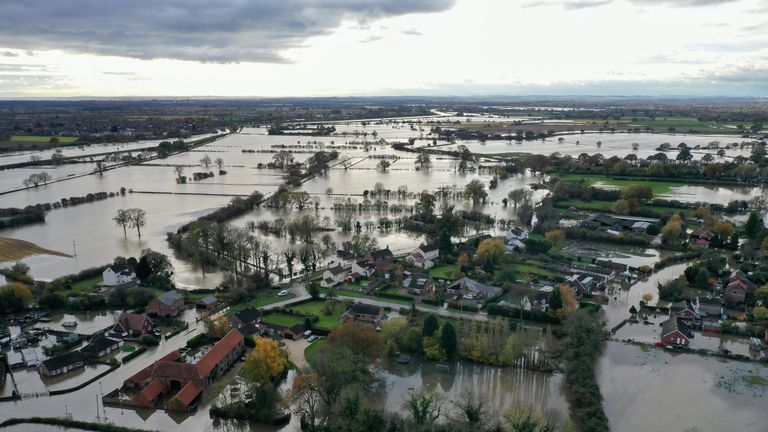Hills, peat, fens and straight rivers – what caused the flood?
The sodden fields of South Yorkshire are a sign of just how poorly prepared we are for our changing climate.
According to the Met Office the amount of rain during downpours has increased by 17% over recent decades.
A wet autumn that had already soaked the soil was followed over the weekend by a month’s worth of rain in just one day.
A rain-band ground to a halt over northern Britain because of high pressure weather systems over Europe.
But Aidan McGivern, a meteorologist at the Met Office, said it’s too soon to pin the blame for the deluge on climate change.
He told Sky News: “These weather events have always happened.
“What we can say is that a warmer world holds more moisture and therefore there is more available rain in the atmosphere to fall.
“These rainfall events are more intense and as a result risk of flooding goes up.”
The floodwater began its journey in the River Don’s vast catchment area high up in the Pennines.
Humans now manage what was once a wild landscape: the hills have been drained, the spongy peat that used to absorb rain has been cut and the heather has been burned.
There is little to hold the water back.
Downstream, the River Don has been straightened over the years, accelerating the flow of water.
And the 60 flood defences built along a five mile stretch around Sheffield protected homes and businesses that were submerged in 2007.
But they just pushed the problem downstream.
Professor John Grant of Sheffield Hallam University said: “What we’ve done is increase the capacity of the rivers that pass through Sheffield, so they carry more water without topping over.
“That’s good as protects many lives. But when that increased water volume hits the first point without high banks, that water just seeps its level.”
The flooding has hit the area around Stainforth, near Doncaster, where the prime minister visited, particularly badly.
The village is on the edge of the Humberhead levels, a huge boggy fen that was drained in the 18th Century to create farmland.
But Professor Grant said building on fenland has its perils.
“If something was a fenland or a marsh or flood plain, the clue is in the title. That used to absorb vast quantities of water.
“Now, with our hubris, we think we can build tarmac and brick and houses on this and expect that run-off to do what? Just magically evaporate or enter into our huge rivers?
“No, it’s going to stay and it’s going to cause a problem.”
The Met Office predicts that climate change will make our winters wetter, with rainfall increasing by a third over the next 50 years.
Hannah Cloke, professor of Hydrology at the University of Reading, said far more needs to be done to prepare.
“I don’t think we are resilient to a changing climate,” she told Sky News.
“We are on the back foot and that really worries me – we can’t cope with the floods we have now.
“So we need to think what we are doing with flood risk management.
“We could pay farmers to hold water back in the uplands and also to store water on the flood plain to protect urban areas where there are lots of people.
“That seems like a fair solution.”
:: A New Climate is a series of special podcasts from the Sky News Daily. Listen on Apple Podcasts, Google Podcasts, Spotify, Spreaker
Source: Read Full Article




